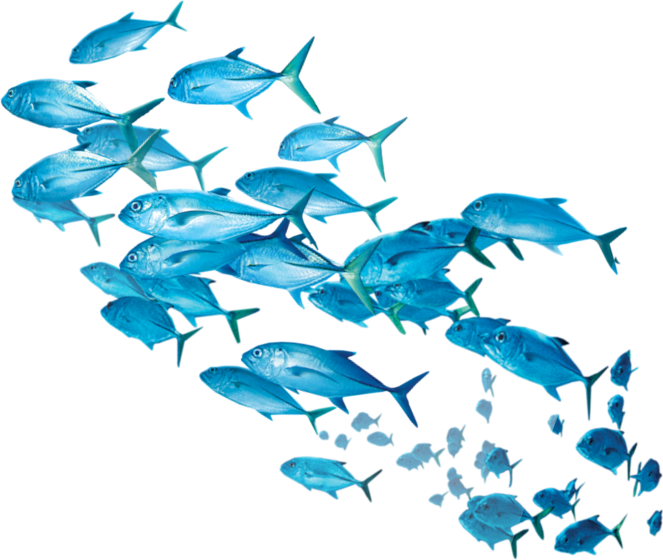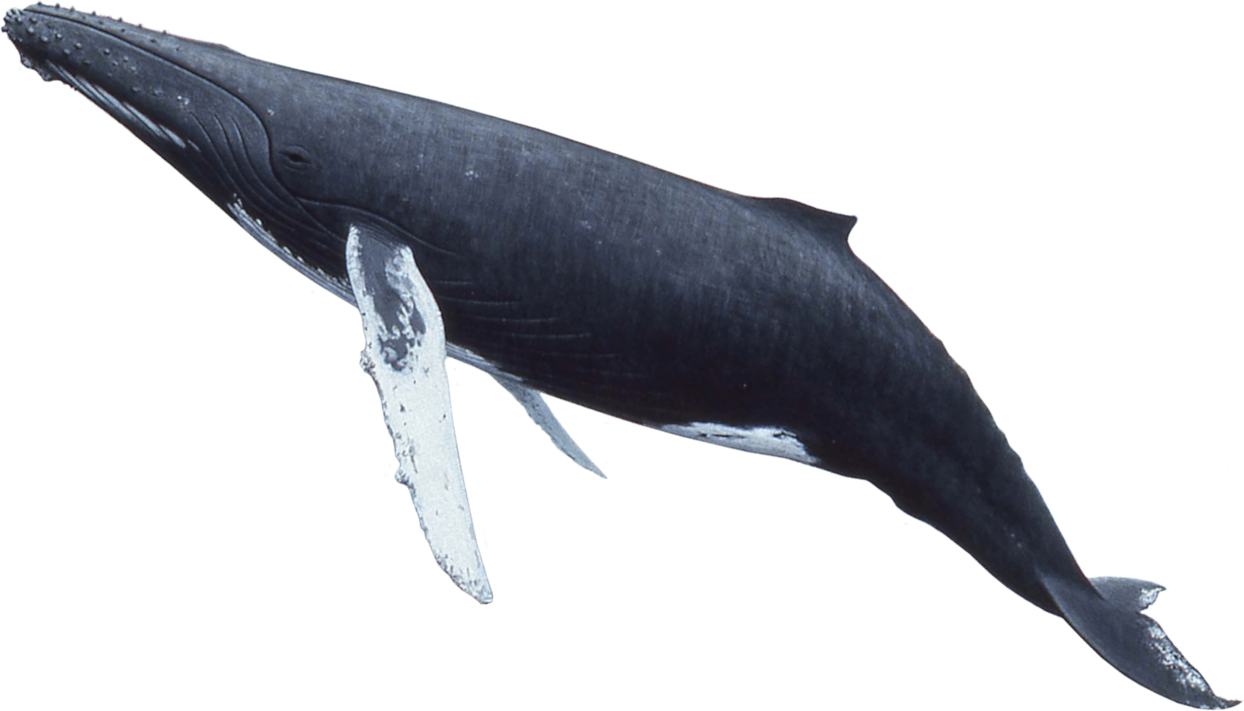When speaking about our global environment, a common adage to hear is that “we know more about outer space than we do about the ocean.” In some ways, this statement is true! The oceans are vast, and exploring them is dangerous and difficult — in some ways, it’s even more difficult than exploring space. Still, our lack of knowledge about certain aspects of our oceans doesn’t mean we haven’t made an impact on them. This exclusive Faunalytics Fundamental examines our relationships with ocean life, exploring some of the most important issues facing fishes, aquatic mammals, and other species, based on the best available and current data. We hope you find the information useful in your advocacy, and in your day-to-day lives advocacy. Please be sure to check out all of the source links embedded in the text and infographics below, and be sure to check out the blog about what we included, and what we left out.
Meet the Animals
Unlike companion animals, certain kinds of wildlife, and even farmed animals, there are relatively few opportunities to “get to know” ocean life. As with farmed animals, many people only get close to or experience ocean creatures after they’ve already been killed, processed, and plated. In other cases, people may “meet” animals like whales, dolphins, and other species in situations of extreme and unnatural captivity, like zoos and aquariums. Even with activities like whale watching, it can be difficult to truly “know” the vast range of ocean life out there. Below, we look at different categories of ocean life and just how incredible they truly are.

Fishes We Consume
Some estimates say the oceans are home to 20,000 species of fish.
- Good Memories – Some wild fish species have excellent memories, and can remember being caught for up to 11 months
- On The Edge – The United Nations Food and Agriculture Organization reported in 2016 that 94% of fish stocks are fully fished or overfished
- Social Species – Fishes exhibit sophisticated social behavior: they solve problems involving complex coordination, precise memory, and decision making

Marine Mammals
Marine mammals play a variety of roles in the environment, including herbivores (manatees), filter feeders (baleen whales), and top predators (killer whales).
- The Songs Of The Sea – Male humpback whales love to sing, and their songs change throughout the season
- The Biggest Of All – The Antarctic blue whale is the biggest animal on the planet, weighing up to 400,000 pounds (approximately 33 elephants) and reaching up to 98 feet in length
- Complex Evolution – Mammals evolved on land around 160 million years ago. Some of those land mammals then ventured back into the ocean environment

Cephalopods, Crustaceans, & Shellfish
According to the Natural History Museum of Los Angeles County, there are over 52,000 species of crustaceans.
- Spineless & Mighty – Colossal squid are not only the largest invertebrates on Earth, they also have the largest eyes of any animal
- Amazing Octopuses – Octopuses have three hearts, they squirt ink to deter predators, and being boneless, they can squeeze into (or out of) tight spaces
- Old Souls – The ocean quahog is known to live at least 500 years, and is referred to as “the oldest known animal”

Corals and Invertebrates
Coral reefs cover less than 1% of the ocean but are home to almost 25% of all known marine species.
- Always On Pause – Barnacles are animals who cannot move — after a short phase as larvae, they settle and never move again
- A Good Filter – American oysters are filter feeders that strain organic matter from the water. Each American oyster filters approximately 50 gallons of water per day
- Animal Earrings? – Corals have long been popular as jewelry and other souvenirs, but many are unaware that these beautiful structures are made by and of living creatures
Attitudes
While most people don’t have a direct connection to ocean life, that doesn’t stop people from having opinions about it! Whether it’s trophy fishing, marine conservation, pescetarianism, or any other issue, all of us land-dwelling humans have a lot of ideas about the oceans, marine life, and what our responsibilities to these amazing creatures are. Below, we explore some of the key attitudes people have about the state of our oceans, and their protection.
As with any other broad animal issue, it’s important to note that these attitudes aren’t fixed: public opinion changes over time and will continue to change in the future. This is good news, because with so many of the ocean life issues we’ll outline below, we need much more support and action from the general public to help shift the current tides.
Fishing, Bycatch, & Ghost Gear
By far the biggest threat to ocean life is fishing, and the cascade of negative effects that comes with it. We take a staggering number of fishes from the oceans every year, by some estimates far more than all species of land animals we kill for food each year combined. While many people look at the oceans as so vast that their consumption of fishes doesn’t matter, that is a fallacy that couldn’t be farther from the truth — Faunalytics’ Animal Product Impact Scales are evidence of this. The global fishing industry is a juggernaut, consumption levels are expected to rise in the coming years, and each individual consumer of fish contributes to its staggering scale.
Unfortunately, it’s not just the fishes that we consume directly who suffer for our appetites. The related problems of bycatch — fish who are caught up in fishing nets who are not the “target species” of the fishery in question — and ghost fishing gear — discarded fishing gear that continues to entangle, trap, and kill fishes for long after it’s been used — mean that there is a vast number of animals that suffer for our food who are not even consumed. They just happen to be in the wrong place at the wrong time, and they never even make it to someone’s plate. In the chart below, we explore the ways these indirect phenomena impact ocean life
Captivity: At Home and In Labs
On a much smaller scale than the use of marine animals for food, we capture ocean creatures and use them regularly in a variety of ways. Zoos and aquariums are the most visible places where marine animals are kept in captivity (more on that later), but the numbers of fishes living in that type of captivity are relatively small. On a more hidden level, however, marine animals are kept in our homes as “companions” and in laboratories as research subjects. People who keep companion fishes aren’t “hiding” them per se — indeed, many make a point of showing them off — but the industry that surrounds companion fishes is opaque, to say the least. Meanwhile, the use of aquatic animals in research is widespread, and receives scant attention, even among research animal advocates.
Why look at fishes used in experiments in the U.K., but not the U.S.? The answer is simple: fishes aren’t covered by the Animal Welfare Act in the U.S., so there is no legal mandate to count them or reduce their pain and suffering. Whether they live in our homes as “companions” — in quotes here because the bond we can form with them behind glass is questionable — or in laboratories for our experimentation, our extensive use of them is evidence of just how much we have reached into the oceans for our own gain.
Species On The Brink
Every once in a while, a species becomes a particular focus of human use in such a way that it places immense pressure on their populations. On land, for example, rhinos have been hunted and poached to the edge of extinction because of our particular desire for rhino horns. A similar dynamic played out for many years with elephants, who were killed for their ivory tusks. In these cases, animals are often sought out for one very specific part, while the rest of the animal is discarded or left behind, adding further indignity to their deaths.
Below, we look at two of the most well-known examples and their impact on ocean life: shark finning and whaling. In the case of shark finning, animals are killed purely for their fins and discarded, often dying horrific deaths (warning: graphic content) as they lose their ability to swim (and thus, to breathe), and essentially drown. Shark fins are used in shark fin soup, which is a luxury dish in some cuisine. In the case of whaling, animals are killed for subsistence hunting, commercial meat sales, or for “research,” and often time these killings are done in violation of international agreements.
Fortunately, issues like shark-finning and whaling have received a great deal of public attention, and have also inspired many to action: they’ve been the subject of intensive international campaigns and numerous documentary films, which have forced policymakers around the world to pay attention and make change. Those changes, while still not necessarily “enough,” are part of a growing movement to protect our oceans and their inhabitants, while we still can.
Conservation & Sanctuary
The oceans are huge and powerful, but they are also incredibly vulnerable. We may think of them, and the marine life that inhabits them, as just about infinite, but nothing could be further from the truth. Humans have made a significant impact on the oceans, causing everything from coral bleaching to plastic pollution and beyond. Below, we look at some of the most important conservation issues facing ocean life today, and how some advocates are making a difference.
Part of the reason we are animal advocates is that we believe we can make a positive difference in the world. When it comes to our oceans, making an impact may seem difficult, but everything we do acts as another restorative drop into the sea. Above, we looked at some particularly heavy issues and there is so much work to be done. Below, we look at one intitiative in particular, the Whale Sanctuary Project, and how they are working to build a model where formerly captive whales and dolphins can be rehabilitated and live permanently in a natural environment.
This Faunalytics Fundamental has provided a visual overview of our broad and complex relationships with ocean life, but we’ll be the first to admit this resource is incomplete. Be sure to check out the accompanying blog post to understand how we made our choices of what to include and what to leave out.
Whether you’ve ever been involved in ocean advocacy, or are already a seasoned veteran, we think you’ll find the data above useful in a variety of ways, and we’d love to hear how you use it in your work.
We hope the data presented here also encourages advocates to ask questions about how to be more effective and how best to invest our limited advocacy resources:
- How can we meaningfully reduce the consumption of fishes — not just directly as human food, but indirectly as fish meal used in agriculture and in food for companion animals?
- What kinds of interventions and advocacy campaigns would make the biggest impact on reducing the number of fishes kept as companion animals?
- What are the most immediately winnable issues in terms of ocean conservation? For example, does the shark finning / shark fin soup issue have enough leverage points that advocates can act upon to end the industry?
- How can projects like The Whale Sanctuary be promoted, expanded, and replicated, and could such projects help to speed up an end to marine mammal captivity globally?
These are questions advocates should think about and potentially research further.
There is so much more work to be done to give animal advocates the insight they need to choose the most effective ways to help animals. Please donate generously now to help us keep bringing you and other advocates this crucial information.
Faunalytics would like to thank The Joanna Toole Foundation
for their generous support of our Ocean Life Fundamentals.


